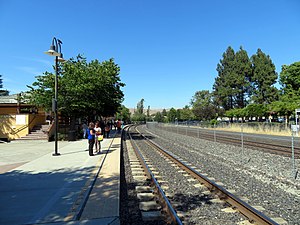Fremont station
 From Wikipedia - Reading time: 8 min
From Wikipedia - Reading time: 8 min
 The platforms at Fremont station in July 2018 | ||||||||||||||||||||||||||
| General information | ||||||||||||||||||||||||||
| Location | 37260 Fremont Boulevard Fremont, California United States | |||||||||||||||||||||||||
| Coordinates | 37°33′33″N 122°00′26″W / 37.559097°N 122.007176°W | |||||||||||||||||||||||||
| Owned by | City of Fremont | |||||||||||||||||||||||||
| Line(s) | UP Niles Subdivision[1] | |||||||||||||||||||||||||
| Platforms | 2 side platforms | |||||||||||||||||||||||||
| Tracks | 2 | |||||||||||||||||||||||||
| Connections | ||||||||||||||||||||||||||
| Construction | ||||||||||||||||||||||||||
| Parking | Yes | |||||||||||||||||||||||||
| Accessible | Yes | |||||||||||||||||||||||||
| Other information | ||||||||||||||||||||||||||
| Station code | Amtrak: FMT | |||||||||||||||||||||||||
| History | ||||||||||||||||||||||||||
| Opened | September 1910; June 4, 1993 | |||||||||||||||||||||||||
| Closed | 1941 | |||||||||||||||||||||||||
| Rebuilt | June 1999 | |||||||||||||||||||||||||
| Passengers | ||||||||||||||||||||||||||
| FY 2023 | 29,125[3] (Amtrak) | |||||||||||||||||||||||||
| Services | ||||||||||||||||||||||||||
| ||||||||||||||||||||||||||
| ||||||||||||||||||||||||||
Fremont station (also known as Fremont–Centerville station) is a train station located in the Centerville area of Fremont, California, United States. The station is served by Amtrak Capitol Corridor commuter rail/intercity rail service and the Altamont Corridor Express (ACE) commuter rail service. The station has two platforms serving the two tracks of the Niles Subdivision. Most trains use the longer west platform (Platform 1).
History
[edit]
Centerville's first Southern Pacific Railroad station was nothing more than a boxcar, functioning in that capacity from May 1909 to September 1910. In that month the current wooden structure was opened. It was one of sixty Type 23 stations built by Southern Pacific, and its cost was under $5,000 USD (equivalent to $163,500 in 2023).[4] The station was a busy one during its early years, handling both freight and passenger traffic, including two to three daily milk trains. By the mid-1920s, automobile traffic began to grow, and the milk trains were discontinued. Passenger service ended on March 29, 1940. The Railway Express Agency continued shipping to and from the station until 1958. The station was completely closed on September 30, 1961.
The station changed hands many times in the following decades, becoming a furniture store, a spice store, a toy store, and an electronics store at different times. Its condition deteriorated, however, and in 1991 it was abandoned. The Depot Diner, located at the west end of the depot, contains the historic "creamery" counter and chairs from Cloverdale Creamery (which closed in 2000). Fremont Flowers (which in 1956 opened in the depot) moved the original diner chairs and counter to the depot. The owner of the flower shop also owns the Depot Diner.
On June 4, 1993, Amtrak restored service to the depot.[5] In December of that year, it was acquired by the city. On March 15, 1995, the station was moved from the south side of the tracks to the north side of the tracks; it was also rotated 180 degrees to allow for more parking space. The station was restored between October 1998 and June 12, 1999. The cost of these projects was over $900,000.[4] The station now appears as it did in 1910. On November 23, 2002, a platform and shelter was built on the south side of the tracks. It is called the Bill Ball Plaza, named after a former mayor of Fremont.
In 2018, ACE was awarded $3.4 million to extend one platform at Fremont to accommodate ten-car trains.[6][7] The platforms were rebuilt in 2022–23 to improve accessibility as part of a 2020 Amtrak settlement.[8][9][10] The work cost $4.2 million.[11][12]
The Dumbarton Rail Corridor project, which has been studied several times since the 1990s, would have Fremont as an intermediate station.[13] A 2016-released Vision Plan called for Capitol Corridor trains to be rerouted over the Coast Subdivision, which is used by less freight service. Ardenwood Park & Ride would replace Fremont station for Amtrak service, though ACE service would still use Fremont.[14]
References
[edit]- ^ SMA Rail Consulting (April 2016). "California Passenger Rail Network Schematics" (PDF). California Department of Transportation. p. 4.
- ^ "Transit Information Fremont Centerville Station" (PDF). Metropolitan Transportation Commission. March 2, 2021. Retrieved March 10, 2022.
- ^ "Amtrak Fact Sheet, Fiscal Year 2023: State of California" (PDF). Amtrak. March 2024. Retrieved June 26, 2024.
- ^ a b "Fremont". Great American Stations. Retrieved February 2, 2013.
- ^ National Association of Railroad Passengers (June 11, 1993). "Hotline #777". Archived from the original on December 12, 2013. Retrieved July 31, 2012.
- ^ "Two Central Valley Rail Agencies Receive $12.3 Million Dollars in SB 1 Funding" (Press release). Two Central Valley Rail Agencies Receive $12.3 Million Dollars in SB 1 Funding. November 2018.
- ^ "SB-1 State Rail Assistance Program (as of December 22, 2023)" (PDF). California State Transportation Agency. December 22, 2023.
- ^ "Fremont Station Accessibility Improvement Work Set to Begin in February". Capitol Corridor Joint Powers Authority. February 27, 2022.
- ^ "Fremont Station Accessibility Improvement Project Phase 2: 1/23- TBD". Capitol Corridor Joint Powers Authority. January 27, 2023.
- ^ "Americans with Disabilities Act (ADA) Progress Report, December 2023" (PDF). Amtrak. December 2023. pp. 1, 2.
- ^ "Amtrak Celebrates Accessibility Upgrades at Bay Area Stations" (Press release). Amtrak. June 4, 2024.
- ^ "Amtrak Fact Sheet Fiscal Year 2023 State of California" (PDF). Amtrak. March 2024. p. 7.
- ^ "Summary of the Dumbarton Rail Corridor Project Study Report" (PDF). San Mateo County Transit Authority. May 2004. Archived from the original (PDF) on March 18, 2016.
- ^ "CAPITOL CORRIDOR INTERCITY PASSENGER RAIL SERVICE ANNUAL BUSINESS PLAN FY2019-20–FY2020-21" (PDF). Capitol Corridor Joint Powers Authority. pp. 9–10.
External links
[edit]![]() Media related to Fremont station at Wikimedia Commons
Media related to Fremont station at Wikimedia Commons
 KSF
KSF